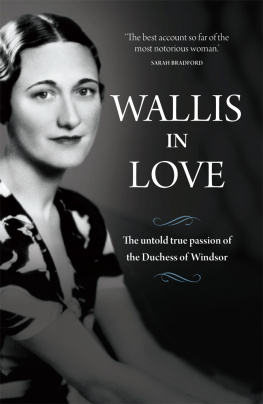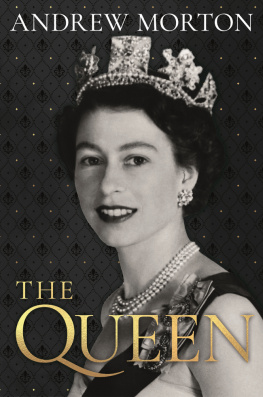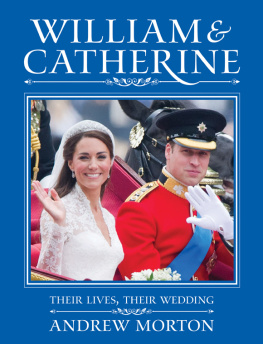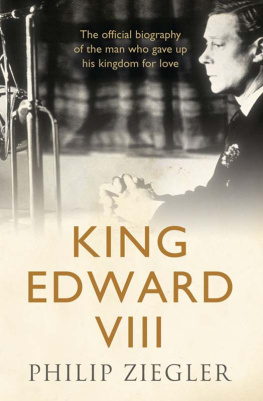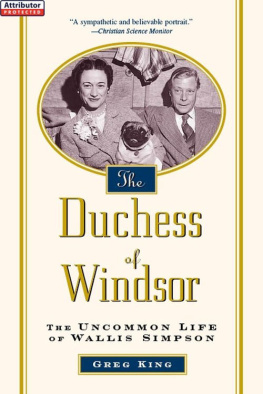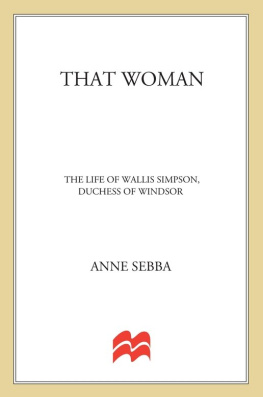Reviews for Wallis in Love
The best account so far of the most notorious woman and most dangerous threat to the British royal family of the twentieth century. Andrew Morton presents a convincing picture of Wallis Simpsons rip-roaring sexual and social adventures and her curious marriage to the Duke of WindsorHis new research adds to our knowledge of her whole career.
Sarah Bradford, author of Americas Queen: The Life of Jacqueline Kennedy Onassis, Queen Elizabeth II and George VI
Remarkable. Supersedes and surpasses all previous Wallis biographies with its wealth of new detail and insight. Andrew Mortons crowning achievement.
Christopher Wilson, author of Dancing with the Devil: The Windsors and Jimmy Donahue
The best-known chronicler of the royals, Andrew Morton, provides tantalizing new details about the scandalous life of Wallis Simpson.
Meryl Gordon, author of Phantom of Fifth Avenue and Bunny Mellon: The Life of an American Style Legend
First published in Great Britain in 2018 by
Michael OMara Books Limited
9 Lion Yard
Tremadoc Road
London SW4 7NQ
First published in hardback in the United States of America in 2018 by
Grand Central Publishing, Hachette Book Group
1290 Avenue of the Americas, New York, NY 10104
Copyright Andrew Morton 2018
All rights reserved. You may not copy, store, distribute, transmit, reproduce or otherwise make available this publication (or any part of it) in any form, or by any means (electronic, digital, optical, mechanical, photocopying, recording or otherwise), without the prior written permission of the publisher. Any person who does any unauthorized act in relation to this publication may be liable to criminal prosecution and civil claims for damages.
A CIP catalogue record for this book is available from the British Library.
ISBN 978-1-78243-722-2 in hardback print format
ISBN 978-1-78243-931-8 in Trade paperback format
ISBN 978-1-78243-723-9 in ebook format
www.mombooks.com
To my mother Kathleen
Contents
T HE GRAND JAS cemetery lies to the north of the Riviera resort of Cannes, the nine-hectare site bounded by the road to the perfume-making town of Grasse.
A brief but stiffish uphill climb brings the curious and the grieving to the entrance of the Protestant portion of the 150-year-old cemetery. The stone pillars supporting the stern iron gates bear the legend I believe in the resurrection of the dead in both French and English.
Inside is a roll call of the famous, the well known and the simply anonymous who were drawn from around the world to make Cannes their home and their final resting place. The English Square, known also as the cimetire anglais, is dominated by a statue of Henry Brougham, who turned Cannes from a sleepy fishing village into the resort town it is today. Laid to rest among the quiet rows are sculptors, singers, pioneer pilots, dukes, soldiers including two holders of the Victoria Cross, the United Kingdoms highest military honour and Peter Carl Faberg of the Russian jewellery family, whose eggs crusted with diamonds, rubies, sapphires and other gems were gobbled up by the last Russian czar. There is a Nobel Prize winner French biochemist Jacques Monod a rhyme of poets, including the Irish bard William Bonaparte-Wyse and writer Klaus Mann, son of Death in Venice author Thomas, as well as the ballerina Olga Khokhlova, Pablo Picassos first wife.
There are lesser lights, too. Those originally from Camden Town in north London, for example, or Victoria in Australia, and, beneath a stand of cypress trees, ones from Hyde Park in upper New York State. While the Americans are well outnumbered by the British, this grave, with its badly discoloured headstone, intrigues. What an extraordinary story the marble slab covers over, of the three silent inhabitants who lie beneath. It is the grave of Herman Livingston Rogers, his first wife, Katherine Moore, and his second wife, Lucy, or Marie Lucie Catherine as she styled herself in later life. The inscriptions on the gravestone state that the first wife was beloved, the second devoted but what of the third woman, who also loved this wealthy Renaissance man who counted princes and presidents in his circle? She was born in a wooden shack in a mountain holiday resort and named Bessie Wallis Warfield. This woman from Baltimore married a Navy pilot, a shipping broker and a king. She deeply touched the lives of all three occupants of this particular plot in Grand Jas and many more beyond. Though one man gave up the English throne for her, it was Herman Livingston Rogers whom she called the love of my life.
Herman was Bessies best friend, her companion, her advisor, and her surrogate husband. Just days before she married her royal suitor, a man who had prostrated himself and his kingdom in order to win her hand, it is believed that she offered to have Hermans child.
Bessie Wallis Warfield was an unlikely seductress, apparently more interested in cooking than coitus, her heart under careful control. Nor was this woman who caused so much chaos and commotion in the British constitution and in the hearts of men much to look at raw-boned, square-jawed, outsize hands, and a rasping voice that some found irritating. Yet she enticed men into her orbit, be they single, married, gay or straight. Women, too, were fascinated by her style and her chutzpah.
Wallis was capable of love, passion and desire but not always with the men she married. She liked to say that hers was a simple story. It was nothing of the kind. Wallis was an endlessly complex and intriguing woman, beguiling, infuriating. There is no plaque outside her Baltimore home at 212 East Biddle Street in once fashionable Mount Vernon, but there are those who believe she should be remembered with a statue on the famously unoccupied fourth plinth in Trafalgar Square in central London for saving the British from her pro-Nazi royal husband at a critical moment in their island saga as they faced Hitlers eager battalions, war-weary and alone. This is the story of a most extraordinary woman who, single-handed, changed the history of the British royal family and arguably the destiny of the British people.

U NKEMPT , UNRULY AND UNTIDY , Miss Minerva Buckner was hardly a model teacher. She ignored school bells, bath schedules and timetables. While she had a brilliant mind and had travelled extensively around Europe, she was feared for her violent temper and mordant wit. The lazy, the slow and the stupid dreaded her classes, where she taught in French and German. Miss Buckner went on like a crazy person. one of her pupils wrote plaintively to her mother.
There was one exception. Bessie Wallis Warfield loved Miss Buckners classes and adored the somewhat doughy and gangling teacher with a haphazard appreciation of personal hygiene. Miss Buckner was her first love, the besotted teenage schoolgirl sitting at her feet in the wooded grounds of Oldfields girls boarding school as she read the love poetry of Arthur Rimbaud and Rainer Maria Rilke.
You who never arrived
in my arms, Beloved, who were lost
from the start
Indeed, the line from Rilkes You Who Never Arrived could have been the theme for Walliss hopeless juvenile enchantment.
Wallis saved her pocket money to buy Miss Buckner presents, on one occasion giving her an enormous fern from a florist in Baltimore, an hours steam train journey away through the heavily wooded Maryland countryside.
Next page
